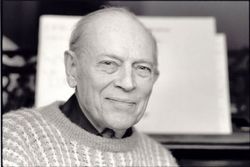Bergman, Erik
Biography
Born: November 24, 1911
Died: April 24, 2006, Helsinki
Country: Nykarleby, Finland
Studies: Helsinki Conservatory (1931-38), Berlin Hochschule für Musik, Sibelius Academy
Teachers: Heinz Tiessen, Vladimir Vogel, Joseph Marx
Website: http://composers.musicfinland.fi Bergman's Music Publisher
Bergman's style ranged widely, from Romanticism in his early works (many of which he later prohibited from being performed) to modernism and primitivism, among other genres. He won the Nordic Council Music Prize in 1994 for his opera Det sjungande trädet.
Bergman studied at the Sibelius Academy in Helsinki and afterwards with Heinz Tiessen in Berlin and with Wladimir Vogel in Ascona. Since 1963 he taught composition at the Sibelius Academy, besides working until 1978 as a choir conductor. Bergman is considered a pioneer of modern music in Finland. Because of his training he was considered as a representative of the avant-garde; he developed for example the twelve-tone techniques of Arnold Schönberg learned from Wladimir Vogel. He composed song cycles, cantatas, pieces for piano and for organ, a guitar suite, a chamber concert for flute, clarinet, bass clarinet, violin, viola, cello, percussion and piano and further chamber works. His Requiem for a dead poet (1970) and Colori ed improvvisazioni for orchestra (1973) gave him international recognition. He is also known for his extensive choral output. His latest works include concertos for cello, violin and trumpet.[1]
Life
Erik (Valdemar) Bergman was an eminent Finnish composer, conductor, music critic, and pedagogue. At Helsinki University in 1931-1933, he studied musicology with the composer and ethnomusicologist Ilmari Krohn - the founder of the discipline in Finland - and literature with the critic and folklorist Yrjö Hirn; concurrently (1931-1938) he was a student at the Helsinki Conservatory - composition with the composer-pianist Erik Furuhjelm and with Bengt Carlson, who had studied under Vincent d'Indy in Paris, and piano with Ilmari Hannikainen, one of the major Finnish pianists. This was followed by further compostion studies with Heinz Tiessen at the Berlin Hochschule für Musik (1937-1939), and the twelve-tone technique with Wladimir Vogel in Ascona, Switzerland (1942-1943).
Returning to Helsinki, Erik Bergman was conductor of the Catholic Church Choir (1943-1950), the Akademiska Sangf6reningen at the University (1950-1969), and the Sallskapet Muntra Musikanter (1951-1978). As a music critic, he wrote for the Nya Pressen (1945-1947) and Hufvudstadsbladet (1947-1976). From 1963 to 1976 he was professor of composition at the Sibelius Academy. In 1961 he received the International Sibelius Prize of the Wihuri Foundation. In 1982 he was made a Finnish Academician. In 1994 he was awarded the Nordic Council Music Prize for his opera Det sjungande trädet (The Singing Tree), which received its premiere in Helsinki on September 3, 1995.
Erik Bergman married first in 1942 Sylvelin Långholm (marriage dissolved 1955), second in 1956 Aulikki Rautawaara (marriage dissolved 1958), third in 1961 Solveig von Schoultz (died 1996), fourth Christina Indrenius-Zalewski.
Music
Erik Bergman was a pioneer of modern music in Finland, ranks among the foremost Finnish composers of his era and one of the most an influential. His roots were in the romantic era, in the 1960’s he was named the enfant terrible of Finnish music and in the 1990’s he was called the grand old man of modernism. Because of his training he was considered as a representative of the avant-garde; he developed for example the twelve-tone techniques of Arnold Schoenberg, and even adopted total serialism in some of his works. Later he arrived at his own, personal style in which tone colours and the search for new expressive means play an important role. His style ranged widely, from Romanticism in his early works (many of which he later prohibited from being performed) to modernism and primitivism, among other genres. He cultivates varied techniques, ranging from medieval modality to serialism. His major works have evolved along expressionistic lines.
Erik Bergman was an exceptionally prolific composer. He composed song cycles, cantatas, a violin concerto, pieces for piano and for organ, a guitar suite, a chamber concert for flute, clarinet, bass clarinet, violin, viola, cello, percussion and piano and further chamber works. He was always fascinated by the human voice. Choral works constitute the majority of his oeuvre and especially male-voice choir a cappella was his core instrument. He has exploited the whole gamut of vocal resources on a sliding scale from speech to song, and his spectrum is remarkable ranging from the mischievous to the mystical. Apart from vocal music has composed a number of works for orchestra which provide a comprehensive cross section of his main stylistic periods. Since the 1970’s Bergman expanded his scale to concertos and chamber music. He was constantly on the move; he had a deep interest in remote cultures and was untiring in his search for the new. His Requiem for a dead poet (1970) and Colori ed improvvisazioni for orchestras (1973) gave him international recognition.[2]
Works for Percussion
Attention!, op.124 - Percussion Quintet
Solfatara, op.81 - Multiple Percussion; Saxophone
Vision Op. 144 - Multiple Percussion
References
- ↑ http://en.wikipedia.org/wiki/Erik_Bergman Accessed April 25, 2014
- ↑ http://www.bach-cantatas.com/Lib/Bergman-Erik.htm Accessed April 25, 2014
